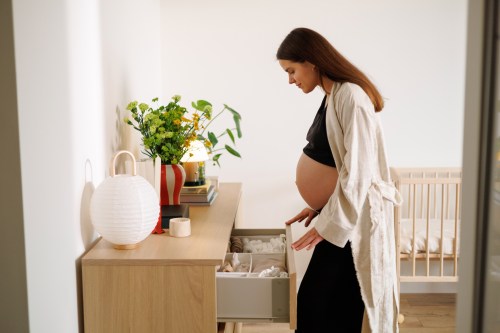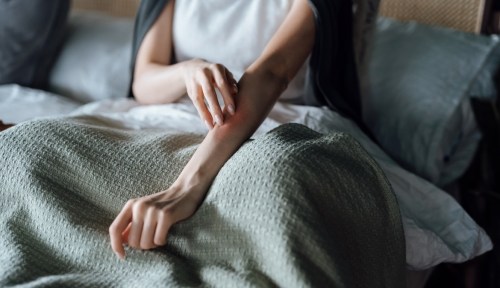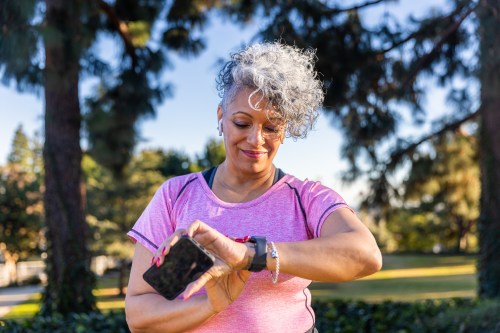It’s a well-known trope in pop culture that when you put a bunch of people with uteruses together in the same house, dorm, or office (or basically anywhere near each other) on a regular basis, their menstrual cycles will sync up like magic. Everyone suddenly starts PMS-ing at the same time, goes through unprecedented amounts of tampons, and eats up all the chocolate and ice cream in sight. Period syncing is such a cultural touchstone that it’s been referenced in shows like Sex and the City and Community, and was a plot point in movies like No Strings Attached.
This isn’t just a TV thing: Texas-based OB/GYN Heather Bartos, MD, says a 1999 survey once found that “nearly 70 percent of women reported feeling their menstrual cycles sync up.” As someone who lived in a sorority house her junior year of college, I’m fairly confident that it happened to me, too.
However, literally every menstrual health expert will tell you that period syncing is little more than an urban legend. Think of it as the Bigfoot of vaginas. But where did it come from…and why do we still believe?
The origins of period syncing
First, a quick primer on what we mean when we actually talk about period syncing: “It doesn’t mean [that people’s menstrual cycles] line up exactly, like start at the exact same time, but become more closely together over a period of time,” Dr. Bartos says.
It’s hard to say exactly where the myth of “menstrual synchrony,” as it’s technically called, originated, but one of the first people to examine this phenomenon was a researcher named Martha McClintock. She had been studying pheromones in mice and noticed that social groups could influence a mouse’ estrous cycle (the name for an animal’s reproductive cycle); she decided to see if it was a thing in humans, too.
In her paper published in the 1971 issue of the journal Nature, she found that after studying 135 different women between the ages of 17 and 22 who all lived in the same dorm at a women’s college, there was a significant increase in “synchronization” (which she defined as a decrease in the difference between the dates people started their periods) between female roommates and close friends. Thus, she concluded that “synchrony and suppression among a group of women together living in a dorm suggests that social interaction can have a strong effect on the menstrual cycle.”
What could explain this phenomenon? “The common theory is that we secrete pheromones, chemicals that are capable of hormone-like activity,” Dr. Bartos says. According to this theory, those pheromones can influence the hormones of other people to make their cycles more aligned to each other. “Some feel menstrual cycles become more aligned with lunar cycles—the typical lunar cycle is about 29.5 days, ironically close to a woman’s cycle length—but these have never gained traction in the scientific community,” she adds.
Debunking the myth
Dr. Bartos says the scientific community is pretty skeptical of menstrual synchrony. It’s a somewhat under-researched area of study, and many studies that do exist have been criticized on the grounds that they are, in the immortal words of Mad Men’s Pete Campbell, “Not great, Bob!”
A 1992 review from the University of Missouri found serious flaws in McClintock’s methodology as well as four follow-up studies that have failed to replicate her results. In each of those instances, for example, researchers followed McClintock’s design and used an “incorrect procedure for determining the initial onset absolute difference between subjects.” Translation: They got the differences in period start dates wrong. When corrected for those errors, the statistical significance was “stripped away” from the results, Scientific American reported in 2007.
In 2017, period-tracking app Clue set out to answer the question once and for all. Partnering with Oxford University professor Alexandra Alvergne, Clue surveyed its users, asking them if they thought their cycles had synced with anyone else, such as a friend, roommate, or sister, who also used the app. After narrowing down the 1,500 responses they received to 360 pairs with at least three similar cycles, they did a statistical analysis based on data the participants input in the app. Clue’s research team found that only 79 of these pairs experienced an actual narrowing in time between period start dates. Instead, Clue found that 273 pairs (the remaining 80 percent) experienced a larger difference in cycle start dates at the end of the study than at the beginning—meaning that users’ cycles were actually diverging from one another, not syncing up.
“It’s very unlikely that cycle syncing is a real phenomenon,” Clue’s data scientist Marija Vlajic told The Guardian in 2017 about the study. “Menstrual syncing amongst the sample we had did not exist. We’ve also done some statistical tests and found that the difference in cycles actually grows. This doesn’t mean that pairs go out of sync—it means they were never in sync in the first place.”
Why it still feels so real
But wait, you say, this has totally happened to me, I swear! Don’t worry, I also had trouble accepting this truth. “So many women tell me it’s a real event for them and their household,” Dr. Bartos says.
But there’s a simple explanation for it: Because most people with uteruses tend to have cycles between 26 and 31 days, there’s bound to be some overlap—there are only so many days in a month, after all.
“It’s probable that women’s cycles change due to stress or lack of sleep,” Dr. Bartos says. Take myself as an example: In college, my sorority sisters and I were likely living similar lifestyles in many ways (hi, all-night “study” sessions fueled by alcohol, energy drinks, and cheap pizza!), which can contribute to a “perceived syncing up of cycles,” Dr. Bartos says. “But with numbers, there can be a measure of chance.”
Plus, when you’re thrown together with someone in tight quarters, you may be more likely to pick up on patterns that don’t really exist. It’s probably easier to remember the time you and your roommate were holed up on the couch inhaling doughnuts because you were both PMS-ing at the same time than to remember all the times you weren’t.
Despite all this, the myth endures. A 2016 research paper in the journal Women’s Reproductive Health speculates that the idea of period syncing is so appealing because it creates a sense of solidarity among people who have periods. “Regardless of whether scientific evidence supports the actual existence of menstrual synchrony, women’s overwhelming beliefs in menstrual synchrony relate to their need to feel solidarity with other women,” the study authors write. Basically, periods are something that most people with uteruses experience, they argue, and the thought that people’s cycles can actually sync up could be regarded as evidence of their shared bond beyond the biological basics. That perceived connection (whether it’s fact or fiction) could make one’s period experience, typically viewed by society as “shameful” and embarrassing, something more empowering and positive.
So yeah, there’s not a ton of scientific evidence that backs up the idea of period syncing. But at the end of the day, there’s nothing wrong with bonding over a little shared period pain. If you and your bestie find —yourself cramping up at the same time, consider it a built-in excuse to pour some wine, queue up that episode of Euphoria on HBO you’ve been meaning to watch, and simply relax. You’ve earned it, period.
Want more period content? Here’s why you shouldn’t be afraid to swim in the ocean when you’re on your period, and here are some of the most common FAQs about mensuration, answered by OB/GYNs.
Sign Up for Our Daily Newsletter
Get all the latest in wellness, trends, food, fitness, beauty, and more delivered right to your inbox.
Got it, you've been added to our email list.











